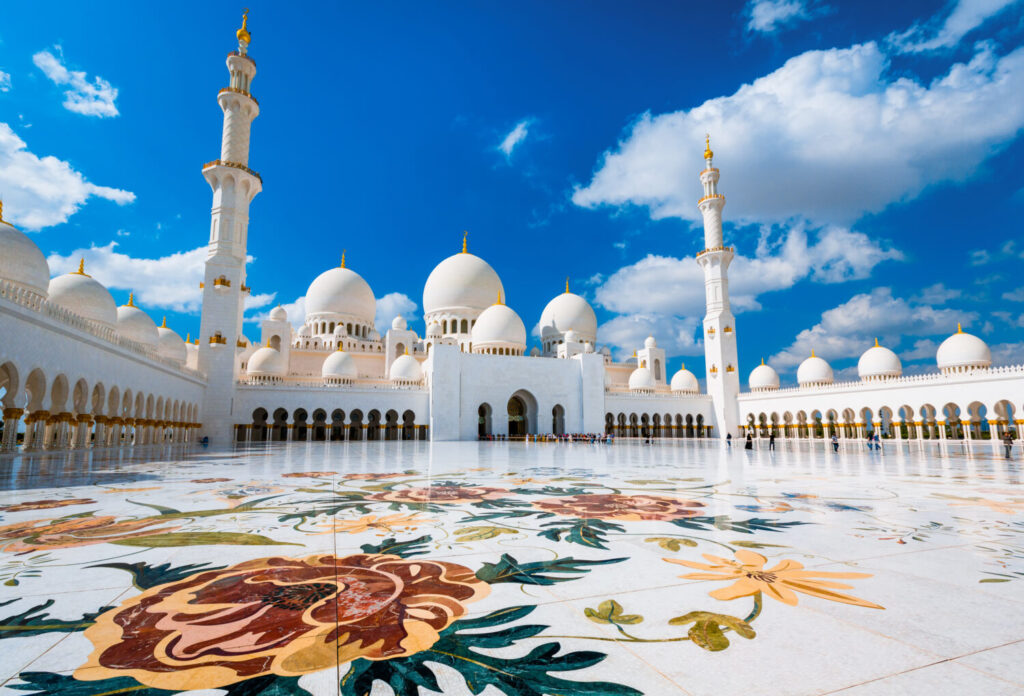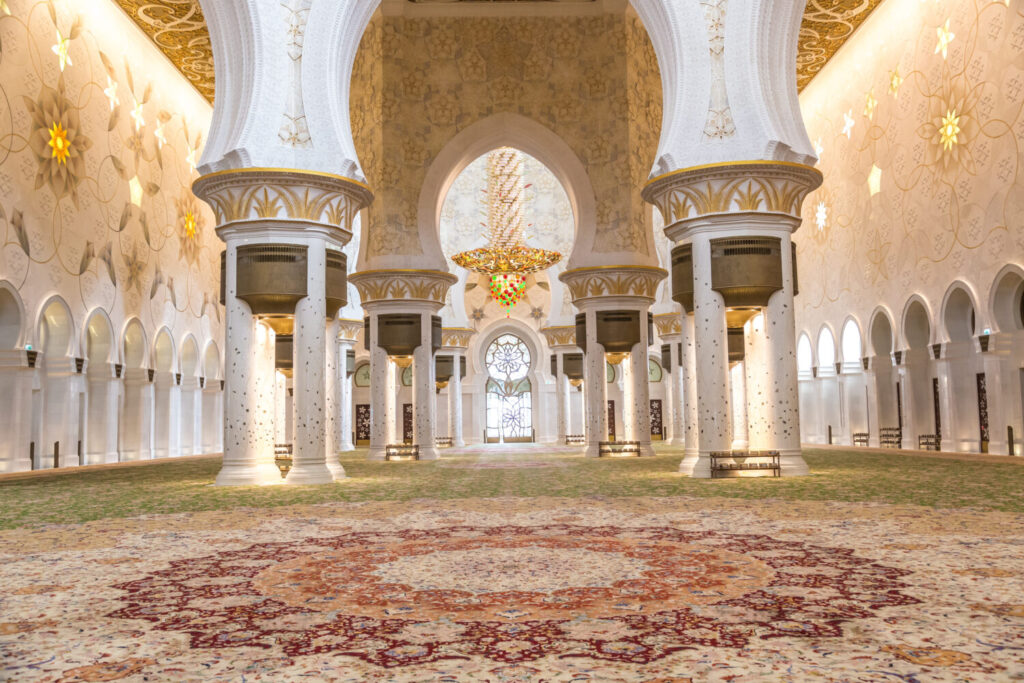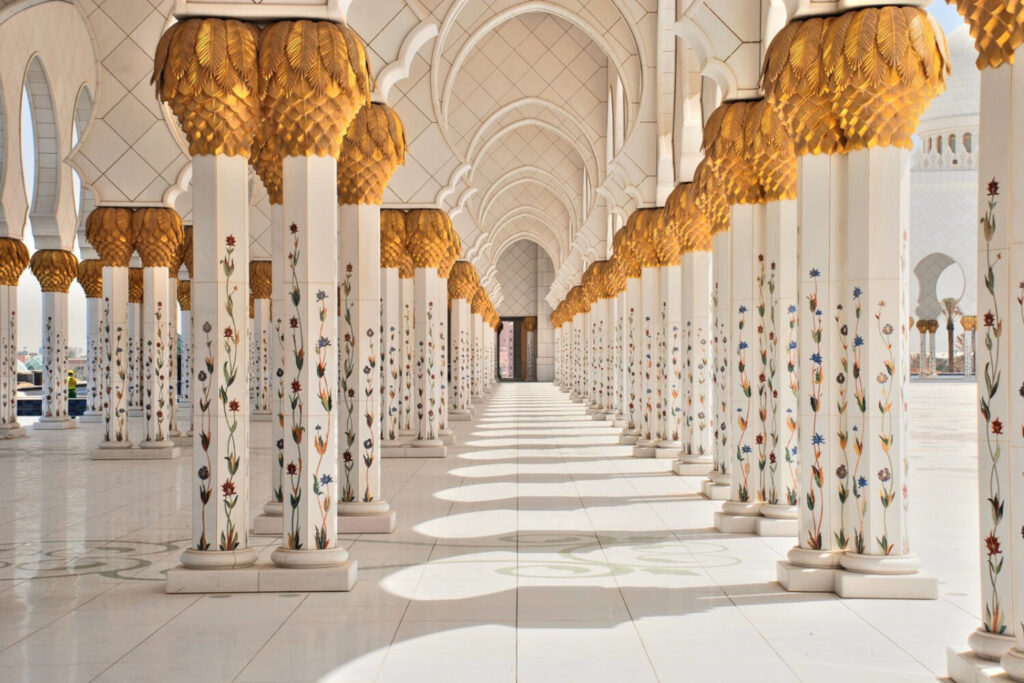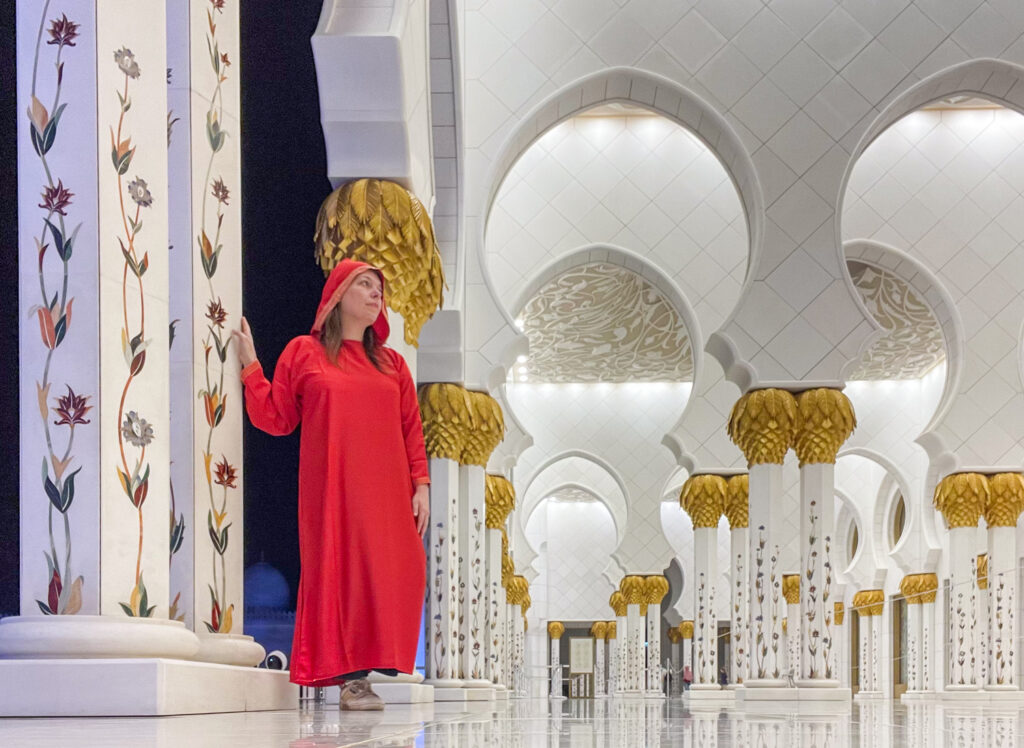The Sheikh Zayed Grand Mosque is Abu Dhabi’s must-visit attraction. Famous for its dazzling white marble and incredible size, this Mosque combines tradition and modern artistry. In this blog post, you’ll find everything you need to know about Abu Dhabi’s Grand Mosque, from its stunning architecture to practical tips for your visit.
Table of Contents
The History of Abu Dhabi’s Grand Mosque
Sheikh Zayed bin Sultan Al Nahyan, the founding father of the UAE, envisioned the Mosque as a symbol of unity and peace for the nation. Construction began in 1996 and took over a decade to complete, involving artisans and materials from around the world.
PLAN YOUR TRIP IN THE UNITED ARAB EMIRATES
The best way to stay connected in the UAE is with a Holafly eSim, which offers unlimited data and fast, reliable internet, ideal for navigating, sharing photos, and staying in touch.
For a worry-free adventure, don’t forget Heymondo travel insurance, offering excellent coverage and great value for money. With both, you can explore Abu Dhabi confidently, fully connected and protected throughout your trip.
Today, the Grand Mosque is presented as a place of worship that reflects Abu Dhabi’s heritage and values. It’s certainly worth a visit because its scale and architectural beauty are impressive. However, it feels more like a display of grandeur than a place for spiritual connection.
The focus seems to be on breaking records and attracting visitors with its vast dimensions and luxurious details. Entering through an underground mall doesn’t exactly help create a sacred atmosphere either. Still, it remains an iconic cultural landmark that draws millions of curious eyes every year.
Who Sheikh Zayed Was and His Vision for the Mosque
Sheikh Zayed bin Sultan Al Nahyan was the founding father and first president of the United Arab Emirates. You can learn more about him in the Etihad Museum in Dubai.
Revered for his leadership and progressive vision, he played a key role in unifying the seven Emirates in 1971. His dream for the Grand Mosque was to create a place that embodied Islamic values of peace, tolerance, and cultural dialogue. He wanted it to be a space open to everyone, regardless of faith, showcasing both spiritual beauty and architectural excellence.
Building the Mosque: Timeline, Challenges, and Global Effort
The construction of the Sheikh Zayed Grand Mosque began in 1996 and spanned over 11 years, with its official inauguration in 2007.
Bringing Sheikh Zayed’s ambitious vision to life was no small feat. The project involved over 3,000 workers and artisans from worldwide, including countries like Italy, Germany, Morocco, India, and China.
One of the biggest challenges was sourcing and assembling high-quality materials from multiple continents, such as white marble from Macedonia, chandeliers from Germany, and carpets from Iran. Coordinating such a vast, multicultural effort required meticulous planning and international collaboration. Still, the result is a mosque that blends global craftsmanship with Islamic tradition.
Why the Grand Mosque Is a Cultural Symbol of Abu Dhabi
The Sheikh Zayed Grand Mosque plays a central role in shaping and expressing Abu Dhabi’s cultural identity. More than a place of worship, it stands as a national symbol of pride, unity, and modern Islamic heritage. Designed to welcome both Muslims and non-Muslims, the Mosque reflects the UAE’s values of tolerance, hospitality, and openness to the world.
Its architectural grandeur, blending traditional Islamic elements with global influences, showcases the Emirate’s ambition to position itself as a cultural bridge between East and West. Through educational tours, interfaith dialogue, and public access, the Mosque promotes a deeper understanding of Emirati culture. However, we’ll return to this aspect further ahead.
That said, as a tourist, what often strikes you most is its monumental scale. It can feel more like a showcase of world records: the largest carpet, the biggest chandeliers, one of the largest mosques globally, than a spiritual sanctuary. And yet, precisely because of this grandiosity, the Grand Mosque has become the unmistakable symbol of Abu Dhabi, celebrated and remembered worldwide.
Inside the Sheikh Zayed Grand Mosque: Architecture, Records and Artistic Wonders
Walking into the Sheikh Zayed Grand Mosque feels like stepping into a world where art, faith, and ambition meet, just like the Hassan II Mosque in Casablanca, Morocco. Its shining white marble, chosen for its purity and elegance, covers almost every surface, creating a stunning contrast against the blue sky.
Inside, the vast prayer hall houses the world’s largest hand-knotted carpet, made by over a thousand artisans and weighing more than 35 tons. Look up, and you’ll see gigantic Swarovski crystal chandeliers sparkling above your head. Each chandelier is a dazzling blend of glass, gold, and craftsmanship. The walls are decorated with delicate floral patterns and verses from the Quran in Arabic calligraphy, a tribute to centuries of Islamic art.
But what strikes most visitors isn’t just the detail, it’s the scale. Everything here is record-breaking, from the size of the courtyard to the number of columns. Like many landmarks in Abu Dhabi, the Grand Mosque doesn’t do subtlety. It’s not just a place of worship; it’s a statement. And it’s very, very big.

Why White Marble Was Chosen and What It Represents
White marble is one of the Sheikh Zayed Grand Mosque’s most striking features, covering its interior and exterior. Chosen for its pure, luminous quality, the marble symbolises peace, purity, and spirituality, which are key values in Islamic culture.
The bright white surfaces create a sense of calm and harmony, reflecting sunlight during the day and glowing softly at night. This choice also enhances the Grand Mosque’s majestic and timeless appearance, making it stand out as a beacon of beauty in Abu Dhabi’s skyline.
Using marble from different countries, the architects blended tradition with international craftsmanship, emphasising the Mosque’s role as a symbol of unity and cultural connection.
Inside the Main Prayer Hall: A Record-Breaking Carpet
The main prayer hall of the Sheikh Zayed Grand Mosque is home to the world’s largest hand-knotted carpet, a true masterpiece of craftsmanship. Created by over 1,200 artisans in Iran, this massive carpet covers an impressive 5,627 square meters.
Made from high-quality wool and cotton, the carpet features intricate floral patterns that complement the Mosque’s overall design. Its size and detail demonstrate incredible skill and make this record-breaking carpet a key highlight of the Grand Mosque’s interior.

Swarovski Chandeliers: Luxury Meets Spiritual Space
The Sheikh Zayed Grand Mosque features seven dazzling Swarovski crystal chandeliers, some of the largest in the world. Made in Germany, these chandeliers combine gold-plated brass with thousands of glittering crystals, adding a sense of opulence to the Mosque.
The largest chandelier, hanging in the main prayer hall, weighs around 12 tons and spans 10 meters in diameter. Despite their luxury, these elements also have a spiritual purpose, symbolising divine light and beauty.
Artistic Details: Floral Motifs and Quranic Calligraphy
At the Sheikh Zayed Grand Mosque, decoration is more than beauty. It’s a bridge to centuries of artistic tradition in a space that speaks to both the soul and the senses.
Instead of paintings or statues, Islamic religious art focuses on abstract forms. That’s why, here, you’ll mostly see flowers and words. In Islamic tradition, depicting people or animals in places of worship is avoided to keep the focus on the divine. The result is a world of geometry, nature, and the written word, where patterns repeat endlessly like a visual meditation.
All through the cool white marble corridors, the walls and columns are covered with floral motifs, inlaid with semi-precious stones like lapis lazuli, amethyst, and mother-of-pearl. These delicate designs celebrate the natural world, harmony, and divine creation.
Alongside the flowers, elegant Arabic calligraphy winds around domes and arches, quoting verses from the Quran in stunning script. Each line was created by master calligraphers from across the Arab world, adding layers of meaning and spiritual presence to every detail.

The Grand Mosque’s Jogging Track
The Sheikh Zayed Grand Mosque isn’t just a mosque. It’s a full complex that includes a shopping mall with an underpass to enter the mosque, and even a jogging track. The idea of jogging in the desert heat might sound weird. I have been to the UAE several times and never once felt the urge to go for a run. And I actually like being active!
Still, the jogging path that loops around the Grand Mosque is surprisingly scenic. It stretches for over three kilometres, offering a peaceful route framed by palm trees, manicured gardens, and the gleaming white domes of one of Abu Dhabi’s most iconic buildings. If you enjoy running, or at least walking with a view, and you’re not afraid of the heat, the jogging track is a unique way to see the Grand Mosque from a different perspective.
What I like is that it’s not just for fitness fanatics. Locals use it for evening strolls, tourists wander around with cameras, and some people just stop to breathe in the calm. It adds a softer, greener side to a place that can otherwise feel a bit like a record-breaking showpiece.
Everything You Need to Know Before Visiting
The Sheikh Zayed Grand Mosque is open daily, but visiting hours vary slightly depending on the season and the religious calendar. Admission is free, which is fantastic, but you will need to book your visit in advance, either online or at the dedicated desk located in the mall directly in front of the Mosque.
Yes, you read that correctly: entrance is through a shopping mall. The mall is modern, air-conditioned, and filled with shops that sell modest clothing and Arabic perfumes. If you expect a quiet, spiritual approach to the Grand Mosque, this setup may feel out of place. The experience is more akin to entering a tourist attraction than a place of worship.
That being said, the Sheikh Zayed Grand Mosque is a tourist attraction worth seeing, mainly due to its size. The Grand Mosque is truly massive, which alone makes it impressive. All the decorations get lost in these huge rooms. It’s Abu Dhabi’s answer to breaking records: the biggest carpet, the largest chandeliers, and so on. You may not feel a deep sense of spirituality, but you will certainly be awed by the scale and architecture.
Make sure to adhere to the dress code: people should wear modest clothing covering their arms and legs. Women are required to wear a headscarf, and rules are stricter for them. I’ll explain further in the article while sharing my experience.
Photography is allowed, but it’s essential to be respectful. Avoid taking photos in worship areas, and always be mindful of people’s privacy, especially during prayer times.
A Tourist Experience, Not a Spiritual One
The official narrative says that the Grand Mosque promotes a deeper understanding of Emirati culture and interfaith dialogue through educational tours, exhibitions, and cultural events. And it probably does, but I didn’t experience that at all.
To be honest, I didn’t even spot the Sheikh Zayed Grand Mosque Centre, which should host exhibitions like the Light & Peace Museum. Maybe it was closed when I arrived in the late afternoon, or not clearly marked, but I didn’t see a single flyer or sign pointing to it.
Instead, my visit felt more like a well-organised tourist flow: enter through the mall, get your timed reservation, pass security, follow the designated path, take a picture by the famous decorated columns… and that’s it. It reminded me of other super popular landmarks where everything is structured to handle crowds rather than foster reflection.
Surely, entering a mosque through a shopping mall doesn’t exactly help you connect with the spiritual atmosphere. So, it’s like having to buy an abaya on the spot in a souvenir shop.
I’m sure that with a guided tour, it would have been easier to appreciate the many artistic and architectural details that make this place special. The Grand Mosque offers daily group tours, but I’m unsure about how to participate. It’s unclear whether you need to be there when the tours start or if a booking system is required. Currently, this information isn’t available on the Grand Mosque’s official website.
I recommend to book a guided visit in advance from Dubai, to better appreciate the Grand Mosque. It’s the best way to give meaning to what might otherwise feel like a walk through a giant (albeit stunning) photo set.
Dress Code for the Grand Mosque: What to Wear
To visit the Sheikh Zayed Grand Mosque, you must dress modestly. For women, this means covering your arms, legs, and hair. A headscarf is mandatory, but it isn’t provided at the entrance. You’ll need to bring your own scarf or be prepared to buy one.
Make sure you’re really well covered. I was wearing a simple T-shirt and was told it wasn’t enough. I had to buy an abaya in the souvenir shop for 45 AED (about €10). It was the budget version: a flimsy synthetic tunic with a hood, available in many tourist-friendly colours. The nicer ones were definitely more stylish… and much more expensive.
Meanwhile, I saw plenty of other Western women allowed in with long-sleeved shirts, trousers, and a random scarf worn over their hair or wrapped around like a skirt. So doesn’t matter if you look a bit ridiculous, the important thing is to be fully covered. To avoid last-minute shopping, bring your own scarf and choose loose, modest clothes that keep you comfortable and respectful.

Opening Hours and Best Times to Visit
The Sheikh Zayed Grand Mosque is open every day of the week, including weekends. From Monday to Thursday and on Sundays, you can visit from 9:00 am to 10:00 pm.
On Fridays, the Grand Mosque opens in the morning from 9:00 am to 12:00 pm, then closes for prayers. It reopens again from 3:00 pm to 10:00 pm.
If you’re hoping for fewer people and better photos, try going early in the morning. The light is soft, the air is cooler, and the crowds haven’t arrived yet. This time is perfect to admire the white marble in peace.
Evenings are quieter, and the Grand Mosque looks beautiful with the changing light, especially at sunset. But if you plan to take photos, late afternoon isn’t ideal. The fading sun flattens the details, and the marble loses some brilliance.
Important tip: if you’re visiting during Ramadan, keep in mind that opening hours change. Always check the official website before you go to avoid surprises.
Is It Free? Entry Info and Ticket Details
Visiting the Sheikh Zayed Grand Mosque is completely free, but booking your entry in advance is mandatory. You can easily make your reservation at the mall in front of the Grand Mosque, at the lower level. It’s pretty convenient if you’re already nearby.
If you like to plan ahead, you can also pre-book your visit online and receive your access pass directly on your phone. This way, you’ll skip the lines and walk straight in when you arrive, making your visit smoother and more relaxed.
How to Get to the Grand Mosque: Taxis, Public Transport, and Parking Tips
The Sheikh Zayed Grand Mosque isn’t in the city centre, but you can still reach it by taxi or public transport. There is a bus stop nearby, though it’s not exactly in front of the mosque, and you’ll have to walk a bit along busy streets to get there.
Keep in mind that the UAE is really designed for cars, so taking a taxi is often the most convenient option. If you’re driving, there’s plenty of parking available too.
I recommend not trying to be eco-friendly by taking the bus as I did, but instead, grab a taxi and enjoy a more comfortable, hassle-free visit to this stunning landmark.
Sheikh Zayed Grand Mosque
Abu Dhabi, 11223
Final Thoughts: Why the Grand Mosque Is a Must-See in Abu Dhabi
The Sheikh Zayed Grand Mosque is undoubtedly a highlight of any trip to Abu Dhabi. Its stunning beauty, rich history, and welcoming spirit offer a unique glimpse into the UAE’s culture and faith. Make sure to experience this architectural marvel firsthand, as it’s an unforgettable journey into the heart of Abu Dhabi, and remember to share your experience in the comment section below!
